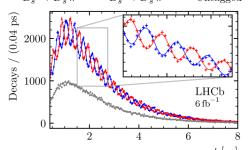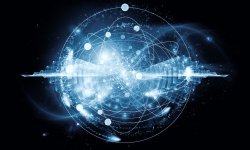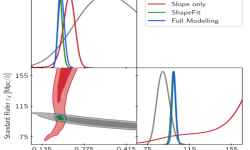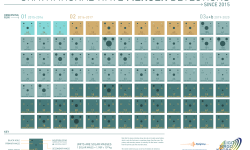
Gemma Busquet Rico, astronomer at the Institute of Cosmos Sciences of the University of Barcelona and the Institute of Space Studies of Catalonia (ICCUB-IEEC) has won one of the five 2022 Leonardo Grants in Physics awarded by the BBVA Foundation.
These grants are given to researchers with ages between 30 and 45 years old of exceptional talent that have highly interesting scientific projects. After thoroughly reviewing more than 100 applications, the BBVA evaluation committee decided to offer one of the five grants to the ICCUB-IEEC astronomer, to help her carry out the project “Towards a new paradigm for the radio emission of Young Stellar Objects”.
With this support, the Leonardo Grants aim to foster talent and originality in research. Each grant consists of a financial aid of 40.000€ that will help researchers carry out their project and strive towards professional consolidation.
Project: A laboratory to understand star formation
The main objective of Dr Busquet’s project is to understand the physics behind star formation and how the rates of mass loss (ejected from the star) and mass accretion (fallen into the star from the stellar disk) determine the final properties of stars.
“We know that during the early stages of stellar formation very powerful phenomena take place where matter is ejected from the star at very high velocities”, explains Gemma Busquet. “The determination of the final mass of the star will depend on the quantity of material that star has managed to keep or to lose”.
The researcher is also the primary investigator of the VOLS project (The VLA Orion A Large Survey). This project, that counts with the participation of 45 international scientists, will observe the northern region of the molecular cloud Orion A using the Karl G. Jansky Very Large Array Telescope in New Mexico (USA) to build a census of the stellar population and characterize their radio emission in two radio frequency bands.
“It is like a laboratory to understand how stars are formed”, she adds. This work will cover a large portion of the sky, equivalent to four times the surface of the Full Moon and with an unprecedented precision and sensibility. This project is crucial for the next generation of radio interferometers since it will provide a data template for Young Stellar Objects and protostars.
With the support of the grant, she will develop tools for the analysis of large amounts of sources with methods based on machine learning, artificial intelligence and Big Data, which are becoming crucial in modern astronomy.
About the researcher
Gemma Busquet Rico (1979, Girona) is a researcher at the Department of Quantum Physics and Astrophysics of the University of Barcelona. She graduated in Physics at that same University, where she obtained her PhD Magna Cum Laude. During her doctorate, she stayed in a number of research institutions such as University College London (UK) and Harvard-Smithsonian Centre for Astrophysics (EEUU). On her postdoctoral stage, she continued her work at the Instituto di Astrofisica e Planetologia Spaziali Italiana (Italy), the Université Grenoble Alpes-Institut de Planétologie et d’Astrophysique de Grenoble (France) and the Instituto de Astrofísica de Andalucía and the Institut de Ciències de l’Espai (ICE) in Spain. Her main area of research is focused on the physical and chemical properties of stellar formation processes.
A research team taking part in the MAGIC collaboration —international consortium including participation from experts of the University of Barcelona— detected very high-energy gamma rays from a recurrent nova in the Milky Way. The results of such observations and the new findings on these stellar explosions have been published in an article in the journal Nature Astronomy, signed by an international team which counts on the participation of the experts Josep Maria Paredes, Marc Ribó and Edgar Molina, from the Faculty of Physics, the Institute of Cosmos Sciences of the UB (ICCUB) and the Institute for Space Studies of Catalonia (IEEC).
The result of this study identifies these novae as a new type of source for very high-energy gamma rays. “This is the first episode detected at such energies and it allows us to better understand these eruptions and their potential role in the production of the mysterious cosmic rays that live in the Milky Way”, notes Professor Josep Maria Paredes, head of the Department of Quantum Physics and Astrophysics of the UB.
A new type of source of very high-energy gamma rays
The end of a star after its death depends on its mass. In about 5,000 million years, when the Sun runs out, it will expand into a red giant star, to end up collapsing into a stellar corpse known as white dwarf. These stellar remnants are dense and, under certain situations, they can produce large explosions. In binary systems where the white dwarf has a red giant star as a companion, the hydrogen from the most external layers of the red giant can succumb to the gravitational attraction of the white dwarf and accumulate on its surface.
This “vampirism” of a stellar corpse towards a star still in the active stage of its life results in a nuclear explosion in the surface of the white dwarf, “it causes it to expel most of the hydrogen and fusion products into interstellar space at speeds of between 2,000 and 4,000 kilometres per second”, says Marc Ribó, ICCUB researcher at the IEEC, vice-coordinator of physics at MAGIC and director of the Montsec Observatory.
This type of explosion is very luminous, it can be up to 100,000 times brighter than our Sun and it is known as a nova. “If the cycle of material transfer between both stars starts again, it can restart the process that will lead, in the future, to an explosion in the systems we know as recurrents”, notes Edgar Molina, also member of the ICCUB-IEEC team working in the collaboration of the MAGIC telescopes.
When the alert of the explosion of the RS Ophiuchi was received, on August 8, 2021, an extensive monitoring system was activated. “The eruption of RS Ophiuchi is a rare event in the gamma-ray sky: it is the most luminous nova and the one with the highest flux detected in gamma rays so far, and we just caught it on time”, says Rubén López-Coto, researcher at INFN Padova and IAA-CSIC of Granada, one of the main authors of the study. A series of observations followed, making this the first nova detected in a wide energy range, both from the Earth and space. On August 9, the MAGIC collaboration used its twin Cherenkov telescope array, located in the Observatory of Roque de los Muchachos, in La Palma island, to observe in the direction of RS Ophiuchi, from which it detected the source.
Thanks to the excellent observing conditions in La Palma, the fast reaction of the collaboration and the high sensitivity of MAGIC, the nova could be detected at energies 100 billion times higher than that of visible light. “This study identified novae as a new type of source of very high-energy gamma rays. Therefore, a new research line in the astronomy of very high-energy gamma rays has been opened”, adds Alicia López-Oramas, IAC researcher and one of the main authors of the study.
Novae, cosmic proton accelerators
Together with data at other wavelengths —including ground-based optical telescopes like the Joan Oró Telescope at the Montsec Observatory—, the research team could find a new fact: the explosion of the nova was energetic enough to produce strong shockwaves in the medium surrounding the stellar system. These shock waves are the ones accelerating the small subatomic particles present in the interstellar medium up to near-light speeds. Regarding the RS Ophiuchi nova, the model to describe best the observations from MAGIC and other telescopes confirms that the very high-energy gamma rays are produced by protons, positively charged particles that build up the nuclei of hydrogen atoms.
Although nova eruptions are less energetic than their cousins, the supernovas, in which a star dies in a catastrophic explosion, they are also more common. The obtained results by the group in the MAGIC collaboration show that, although most of the cosmic rays permeating the Milky Way are generated in other sources, novae can be surprisingly efficient at accelerating protons in their vicinity.
“Within MAGIC, we have been following up on nova explosions for quite some time already. It is always very gratifying when you see that the efforts pay off and we manage to open new windows that bring deeper knowledge of our Universe”, notes Óscar Blanch, spokesperson of the MAGIC collaboration. “It is the result of the work carried out by many people”, he concludes.
In order to fully understand the complicated association between violent events in the interstellar medium of the Milky Way, we need more observations like those in this article. The MAGIC collaboration will continue working on the celestial surveillance of stellar remnants in the Milky Way and in other galaxies.
The Magic Collaboration
The Spanish community takes part in the MAGIC since its start. Now, among the members of MAGIC are the Institute of Cosmos Sciences of the UB (ICCUB), the Research Centre for Energy, Environment and Technology (CIEMAT), the Canary Islands Institute of Astrophysics (IAC), the Institute of High Energy Physics (IFAE), the Autonomous University of Barcelona (UAB), the Complutense University of Madrid (UCM), and the Institute of Astrophysics of Andalusia (IAA). The Institute for Space Studies of Catalonia (IEEC) takes part in this project through the researchers of the ICCUB unit and the Centre for Space Studies and Research (CERES-UAB). Also, the MAGIC data centre is the Scientific Information Port (PIC), a collaboration between IFAE and CIEMAT.
Reference article:
MAGIC Collaboration et al. “Proton acceleration in thermonuclear nova explosions revealed by gamma rays”. Nature Astronomy, April, 2022. Doi: 10.1038/s41550-022-01640-z.
Further information:
Press Office
University of Barcelona
+34 934 035 544
premsa@ub.edu
The LHCb collaboration has precisely determined the frequency of the oscillation, which is a spectacular and fascinating feature of Quantum Mechanics predicted by Gell-Mann and Pais in the 1950s. They presented their results in a paper published in Nature Physics on January 6.
Gell-Mann and Pais noticed that both the neutral strange meson , and its antiparticle
, decay into a pair of pions, π+π–. Therefore, a
meson can turn into
meson and vice versa following the reaction
↔ π+π–↔
. Thus the two particles,
and
, should be considered in quantum mechanics as a single two-state system. The quantum mechanical treatment leads to the particle-antiparticle oscillation pattern.
In particular, for B mesons, this phenomenon was observed using proton-proton collisions at the LHCb detector at the Large Hadron Collider at CERN. In this experiment, researchers make protons collide and obtain and
mesons as a result. These mesons can directly decay through the processes:
However, there is a secondary, less probable process that the laws of Quantum Mechanics predict, which is the oscillation of these neutral mesons:
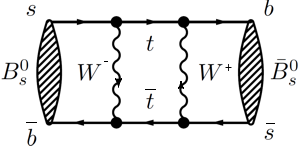
Credit: LHCb collaboration
To determine that a meson has oscillated, first we need to know its quark composition right after it is produced in the proton-proton collision. Quarks are the elementary particles that form mesons, so by analysing the quark content of the particle we can determine if it corresponds to a or a
meson. Secondly, we need to know the quark composition after the B meson decays into other particles. This way, we can know if the meson has oscillated in between these two instants. For example, if we part from a
meson and we obtain the
products after the decay, we can confirm that the meson has oscillated into its antiparticle:
In the following figure, we can see the number of events detected that had oscillation between the mesons (in red) and no oscillation (in blue). The total number of events measured at a certain instant is proportional to the number of mesons present at that time, therefore, if the events with oscillation increase, the ones without oscillation must decrease, making the sum of both proportional to the total number of mesons present at that instant. That is why the minimums of the red line correspond to the maximums of the blue one and vice versa.
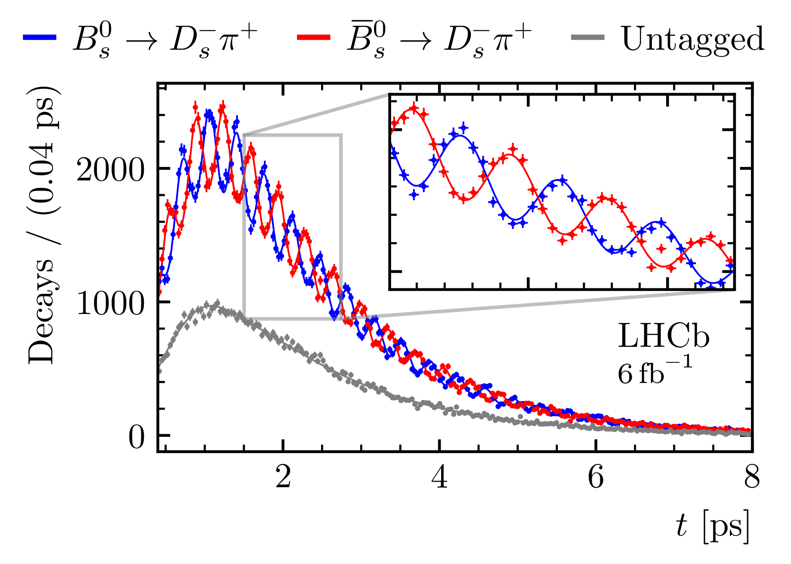
Credit: LHCb collaboration
Even more, the oscillation frequency is measured and calculated with such a precision that it allows us to test the Standard Model comparing the observed value of this frequency to the value predicted by the theory. This also provides one of the strongest constraints to alternative models beyond the Standard Model.
The image of the oscillations is a beautiful visual example of the quantum-mechanical nature of our universe.
Read more in the LHCb paper and conference presentation. Preliminary results have been already presented at Les Rencontres de Physique de la Valée d’Aoste.
The LHCb collaboration
The LHCb collaboration comprises numerous international institutions worldwide, including the Institute of Cosmos Sciences of the University of Barcelona. Several members of our Institute are part of this collaboration, such as Alejandro Alfonso Alberto, José María Fernández-Tenllado Arribas, Paula Garcia Moreno, Lluís Garrido, Pere Gironella Gironell, Sergio Gómez Fernández, Eugeni Graugés, Aniol Lobo, Albert Lopez, Carla Marín, Joan Mauricio and Ricardo Vázquez.
The ADMIRA project published yesterday, January 19, its first scientific paper “ADMIRA Project: teaching particle physics at high school with Timepix detectors” on the Physics Education IOP journal.
In this paper, the authors address the relevance of the ADMIRA (Activitats amb Detectors Medipix per Investigar la Radiació a l’Aula) project from several points of view, putting special emphasis on the importance of experimentation in higher education. One of the characteristics of the pre-university physics curriculum in Spain, as well as in other countries, is the lack of concepts and models corresponding to physics developed during the second half of the 20th century. Furthermore, when introducing the basic concepts of the physics of the Standard Model (SM), or even the atomic-molecular theory of matter, the difficulty that students have in accepting the description of the model, is quite high. The fact that the mathematics involved in theoretical development is well above the level that the students have previously acquired, also does not help to make a formal mathematical description of the subject.
Therefore, in the case of the approach of the SM for secondary education, experimentation is a key tool that can help students grasp these abstract concepts and gain a solid physical intuition of particle physics phenomena. This can inspire many young adults to pursue STEM careers or, if not that, to become better-informed, self-critical citizens of tomorrow’s society. “The use of CERN developed Timepix detectors and their effect on the motivation of the students has been widely documented by the Institute for Research in Schools (IRIS), as well as its effects by increasing STEM vocations, especially among girls”, remarks Daniel Parcerisas, first author of the publication, who has seen this effect on his own students. The detector and readout allows the students not only to research topics related to particle physics but also in other fields like dosimetry, medicine, chemistry or information technologies.
The project has allowed for the creation of a network of students, teachers and researchers from the participant institutions that fosters knowledge transfer and strengthens the scientific and educational local communities.
The ADMIRA project
The ADMIRA initiative originated in late 2017 arising from the collaboration of several individuals from different institutions with the aim of creating a local network of schools using Timepix detectors, designed at CERN, to introduce particle physics into the classroom. The ultimate objective of the project is to bring research closer to the students in order to promote new scientific and technical vocations.
In order to do so, it has established, since September 2019, a loan system for the detectors during a few weeks for the different schools participating in the initiative. It also provides training to the teachers to optimally use the detector and on topics related to particle detection.
Currently, there are 20 schools participating in the program in the academic year 2021-2022, with more than 200 students that used the detectors to take measurements in the labs and experimentally study particle physics. In the project’s website, you will be able to find the work of some of these students, as well as use the materials and activities proposed by the participant teachers.
The published article is the result of a collaboration of individuals from different and complementary educational and research institutions. “Even though I might have led the coordination of this work, this is a collective achievement that involves many people from diverse areas: CERN, the schools, the ICCUB, the IDP-ICE…” states Mr. Parcerisas. He also adds that “Counting with Rafael Ballabriga as main co-author and being able to benefit from his experience in publishing scientific papers has been priceless, and it has allowed me to learn a lot of things during this process”. Rafael Ballabriga (CERN) and professor Eugeni Graugés (Institute of Cosmos Sciences of the UB) have had a leading role in the project since it started in 2017.
Looking ahead, the CERN participants are working to disseminate the lessons of ADMIRA, and other educational experiences related to Medipix/Timepix devices, more widely throughout the CERN member states and beyond. The CERN Medipix team has acquired several Timepix readout systems to be distributed through institutes and individuals already involved in the Medipix Collaborations. The idea is to bring many of the key aspects of ADMIRA to build local networks, magnifying the global impact of the project. The initiative is called Timepix Teachers Network.
More information
D. Parcerisas et al. ADMIRA project: teaching particle physics at high school with Timepix detectors. Physics Education IOP, 2022
Contacts
Daniel Parcerisas
d.parcerisas@safagava.edu
Rafael Ballabriga
rafael.ballabriga@cern.ch
An international team of theoretical researchers that counts with the participation of Dr. Luca Tagliacozzo from the Institute of Cosmos Sciences of the University of Barcelona (ICCUB) provides a thorough overview of quantum physics and its introduction to particle and nuclear physics.
In these last decades there has been an amazing progress focused in isolating and manipulating individual quantum systems, and studying in-depth quantum many-body phenomena to accomplish outstanding results and achievements in the field.
Constituted as one of the pillars of quantum technologies, quantum simulators are considered a specific branch of quantum computing. While quantum computing deals with more generalized computing processing problems, quantum simulators tend to tackle specific problems to find specific solutions.
Now, quantum simulators offer the possibility to gather information about many-body systems in condensed matter physics and even high energy physics and also to learn about complex quantum systems, which are either not accessible to experiments or cannot be approached using standard analytical or numerical approaches. In order to study those systems, these simulators use superconducting circuits, ultracold atoms, trapped ions, Rydberg atoms and photonic systems, among others, to mimic these systems in order to understand and be able to describe and model them.
In a recent review paper published in Philosophical Transactions A, a team of researchers including Luca Tagliacozzo from the Institute of Cosmos Sciences (ICCUB) and also several members from ICFO, Ludwig Maximilians University, Universidad Complutense de Madrid, Jagiellonian University, Adam Mickiewicz University, Swansea University, Universität Heidelberg, Johannes Gutenberg-Universität, Vilnius University, Capital Normal University, Forschungszentrum Jülich, University of Cologne, UAM/CSIC, SISSA, University of Innsbruck, IQOQI and the Hebrew University of Jerusalem, has come together to provide an overview on quantum simulations of lattice gauge theory to help enrich the understanding of quantum many-body physics in general and delve into the world of particle and nuclear physics in particular, show what is the state-of-art in these fields, and what are the future perspectives for applications in the field.
More importantly, the researchers bring into this review a novel approach to the lattice field theories by taking the most commonly used theoretical models in gauge theory, and replacing its fermionic matter (electrons, protons, neutrons, etc), with bosonic matter (photons, mesons, etc) since theorists have come to see that these latter elements are more accessible and easier to manipulate for experimentalists.
In the paper, they point out recent achievements in physics by reviewing the bosonic model of Schwinger and how ultra-cold atoms can be used to explore interesting strongly correlated phenomena related to condensed matter and high-energy physics. They also focus on the advances that have occurred lately in the field of quantum simulators and the different platforms used in table top experiments, such as trapped ions, ultracold atoms or superconducting qubits, to allow the study of isolated many-particle dynamics in real time as well as being able to measure higher-order correlations and entanglement.
As ICREA Prof. at ICFO Maciej Lewenstein points out, “By employing atomic systems such as ultracold atoms in optical lattices, an enormous range of paradigmatic models from condensed-matter and high-energy physics are being currently studied using table-top experiments. This is turning Feynman's idea of a quantum simulator into a reality”.
References
Read the full paper at https://royalsocietypublishing.org/doi/10.1098/rsta.2021.0064
Domènec Espriu, Professor of Theoretical Physics at the Institute of Cosmos Sciences of the University of Barcelona (ICCUB), has been appointed director of the State Research Agency by the Governing Council after an open selection call.
The State Research Agency (Agencia Estatal de Investigación, AEI) manages most of the R&D competitive calls and it is the entity responsible for promoting excellence in Spanish research since its creation in 2015. Its main objectives are the promotion of technical and scientific research in all areas of knowledge, the monitoring of financed actions and their impact, and advice on the R&D strategic plan. The Agency has a budget of 825.7 million euros for 2021 and of 1.358 million euros in the 2022 tentative budget, the highest figure in its history.
The director is responsible, among others, for the government and ordinary management of the AEI, the preparation of strategic and operational objectives and budgets. Espriu will also be in charge of relations with international science and research funding organizations, collaborations with public and private research centres, and providing recommendations and strategic actions that increase the Agency’s capacity to meet its objectives.
Prof. Domènec Espriu
Prof. Espriu has a long and outstanding academic and research career. He has made important scientific contributions to the field of theoretical physics and in particle physics phenomenology. Part of his career took place in well-known universities and research institutions (Universities of Barcelona, Oxford, Harvard, and CERN, among others). He joined the University of Barcelona in 1988 to become full professor in 1997.
Prof. Espriu has carried out institutional management and direction tasks as Director of the Institute of Cosmos Sciences between 2006 and 2009, as well as Vice-rector of Research at the University of Barcelona between December 2016 and January 2021. He has extensive experience in research management, as coordinator of the National Particle Physics Program of the State R&D&I Plan and as evaluator of research proposals and activities of various national and international funding agencies; He has also held responsibilities in scientific committees, executive committees and boards of various initiatives and institutions. In 2014 he was elected Professor Honoris Causa at the University of Saint Petersburg.
Research
Espriu’s most recent research focuses on the use of effective field theories to describe strong interactions in extreme conditions. A recent article on this issue can be found here. He is also actively pursuing research on the LHC experiments at CERN (here) and possible extensions of the Standard Model of fundamental interactions (here). Espriu is also interested in the physics of gravitational waves and its connection with fundamental physics and cosmology (here).
More information: Research output
An international team of astronomers led by researcher of the Institue of Cosmos Sciences of the University of Barcelona (ICCUB-IEEC), Chervin Laporte, has revealed a new map of the Milky Way’s outer disc showing remains of tidal arms excited from interactions with satellite galaxies in the distant past using data from the Gaia space mission. The findings have been published in the Monthly Notices of the Royal Astronomical Society on December 14.
“Typically, this region of the Milky Way has remained poorly explored due to the intervening dust which severely obscures most of the Galactic midplane”, says Chervin Laporte, “While dust affects – he adds - the luminosity of a star, its motion remains unaffected. As a result, one can use the stars motion to perform tomography of the Galaxy’s outermost regions.”
The team analyzed the Gaia motion data, available since December 2020, to identify coherent structures. The map revealed the existence of many previously unknown coherently rotating filamentary structures at the edge of the disc. It also gave a sharper global view of previously known structures. Numerical simulations predict such filamentary structures to form in the outer disc from past satellite interactions, however the sheer quantity of substructure revealed by this map was not expected and remains a mystery.
What could these thin structures be?
Our Galaxy is surrounded by 50 satellite galaxies and has engulfed numerous galaxies in its past. At present, the Milky Way is thought to have been perturbed by the Sagittarius dwarf galaxy which confirmed earlier theoretical models. However, in its more distant past it interacted with another intruder, the Gaia Sausage, which has now dispersed its debris into the stellar halo. Accordingly, the researchers formulated the hypothesis that states that these thin structures are remains of tidal arms from the Milky Way disc, which were excited at different times by various satellites.
“In an earlier study, we showed that one of the thread-like structures in the outer disc, called the Anticenter Stream, had stars which were predominantly older than 8 billion years, making it potentially too old to have been caused by Sagittarius alone but more in line with a Sausage origin, says Laporte. “Another possibility would be that not all these structures are actually genuine disc substructures, but instead form the crests of vertical density waves in the disc seen in projection forming an optical illusion that the disc is highly substructured”.
To disentangle the two, the team has secured a dedicated follow-up programme with the WEAVE spectrograph to study the similarities/differences in stellar populations in each substructure. Future upcoming surveys (WEAVE, SDSS-V and PFS) will also shed light into their origins through complementary radial velocities, chemical abundances and potentially stellar ages.
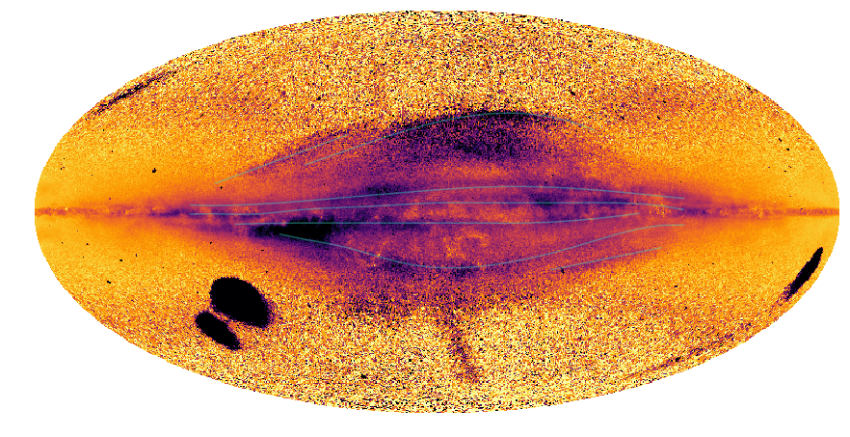
Credit: Laporte et al
Article Reference
C. Laporte, S. E. Koposov, V. Belokurov. “Kinematics beats dust: unveiling nested substructure in the perturbed outer disc of the Milky Way”. Monthly Notices of the Royal Astronomical Society, December 2021. DOI:10.1093/mnrasl/slab109
The new technique to probe the Universe using its large-scale galaxy distribution
Researchers Samuel Brieden, Héctor Gil-Marín and Licia Verde (ICCUB-IEEC) have designed a new clustering analysis technique named ShapeFit, which presents key advantages over the alternative model-dependent approaches. They reviewed the improvements provided by this new methodology in a paper published today at Physics Review D.
With their new technique, they managed to bring together two very distinct approaches to cosmologically interpret large maps of galaxies. Traditionally, spectroscopic surveys such as BOSS and eBOSS use the statistical properties of their galaxy maps to infer the geometry and structure growth of the universe from a billion years after the Big Bang until today in a model-independent way through the standard ruler technique. This technique uses the galaxy two-point correlation function or its analogue, known as the power spectrum.
This function quantifies the excess probability of finding two pairs of galaxies at a given distance, and encodes the vast majority of the statistical information enclosed in the clustering galaxies, including the signature of a cosmic “standard ruler”.
The length of the standard ruler can then be directly linked to the so-called sound horizon, which is the distance that any perturbations were able to travel in form of sound waves in the early universe before recombination (which is the epoch were electrons and protons first became bound to form hydrogen atoms). This so called “standard ruler” is also well measured from Cosmic Microwave Background observations.
By measuring the standard ruler across cosmic time from deep galaxy redshift surveys, the expansion history of the universe can be reconstructed and this now well-known and standard technique goes under the name of Baryon acoustic oscillations or (BAO). However, using the BAO only signal neglects additional (and important) cosmological information, ignoring other features of the power spectrum such as its general slope or the variation of its slope with time, which would give us insights on new physics. On the other hand, we have Full Modelling Fits to the statistical properties of galaxies. These techniques assume a certain cosmological model (for example standard Λ-CDM) and recompute the whole power spectrum to perform their model fits and have, therefore, a much higher computational cost. These approaches reveal that cosmological parameter constraints are more stringent in this model-dependent analysis (blue contours) than in the traditional one (grey contours).
In this work, Brieden, Gil-Marín and Verde show explicitly how, within the traditional approach, this “lost” information can be recovered almost entirely: By adding one extra “slope” parameter. This new parameter captures the shape of the power spectrum on large-scales, which contains information of early-time physics. With this extra parameter (red contours) we can further constrain the cosmological parameters and use the complete galaxy clustering shape to probe cosmological models[SB1] in an effective way. In combination with the geometry and growth information (ShapeFit, green contours) they can accurately reproduce the Full Modelling results, but with major advantages: the preservation of the model-independence of the traditional approach and hence its robustness concerning systematic uncertainties and a much smaller (factor of 30) computational cost.
More information
Read the full article at https://doi.org/10.1103/PhysRevD.104.L121301
Using the European Southern Observatory’s Very Large Telescope (ESO’s VLT), astronomers have discovered a small black hole outside the Milky Way by looking at how it influences the motion of a star in its close vicinity. This is the first time this detection method has been used to reveal the presence of a black hole outside of our galaxy. The method could be key to unveiling hidden black holes in the Milky Way and nearby galaxies, and to help shed light on how these mysterious objects form and evolve.
The newly found black hole was spotted lurking in NGC 1850, a cluster of thousands of stars roughly 160 000 light-years away in the Large Magellanic Cloud, a neighbour galaxy of the Milky Way.
“Similar to Sherlock Holmes tracking down a criminal gang from their missteps, we are looking at every single star in this cluster with a magnifying glass in one hand trying to find some evidence for the presence of black holes but without seeing them directly,” says Sara Saracino from the Astrophysics Research Institute of Liverpool John Moores University in the UK, who led the research now accepted for publication in Monthly Notices of the Royal Astronomical Society. “The result shown here represents just one of the wanted criminals, but when you have found one, you are well on your way to discovering many others, in different clusters.”
This first “criminal” tracked down by the team turned out to be roughly 11 times as massive as our Sun. The smoking gun that put the astronomers on the trail of this black hole was its gravitational influence on the five-solar-mass star orbiting it.
Astronomers have previously spotted such small, “stellar-mass” black holes in other galaxies by picking up the X-ray glow emitted as they swallow matter, or from the gravitational waves generated as black holes collide with one another or with neutron stars.
However, most stellar-mass black holes don’t give away their presence through X-rays or gravitational waves. “The vast majority can only be unveiled dynamically,” says Stefan Dreizler, a team member based at the University of Göttingen in Germany. “When they form a system with a star, they will affect its motion in a subtle but detectable way, so we can find them with sophisticated instruments.”
This dynamical method used by Saracino and her team could allow astronomers to find many more black holes and help unlock their mysteries. “Every single detection we make will be important for our future understanding of stellar clusters and the black holes in them,” says study co-author Mark Gieles from the University of Barcelona, Spain.
Prof Gieles (Institute of Cosmos Sciences of the University of Barcelona, Institut d'Estudis Espacials de Catalunya) studies the dynamics of stars and black holes in dense stellar systems like NGC1850. In his research he looks for ways to “find” black holes in star clusters through their effect on the motions of the stars. The black hole in this binary might be the tip of the iceberg and a large populations of black holes may be present in this cluster. In follow-up studies he will look for other signatures of more black holes in this cluster, and also perform detailed N-body models of this cluster to understand the full implications of this discovery for the black holes population in this cluster.
The detection in NGC 1850 marks the first time a black hole has been found in a young cluster of stars (the cluster is only around 100 million years old, a blink of an eye on astronomical scales). Using their dynamical method in similar star clusters could unveil even more young black holes and shed new light on how they evolve. By comparing them with larger, more mature black holes in older clusters, astronomers would be able to understand how these objects grow by feeding on stars or merging with other black holes. Furthermore, charting the demographics of black holes in star clusters improves our understanding of the origin of gravitational wave sources.
To carry out their search, the team used data collected over two years with the Multi Unit Spectroscopic Explorer (MUSE) mounted at ESO’s VLT, located in the Chilean Atacama Desert. “MUSE allowed us to observe very crowded areas, like the innermost regions of stellar clusters, analysing the light of every single star in the vicinity. The net result is information about thousands of stars in one shot, at least 10 times more than with any other instrument,” says co-author Sebastian Kamann, a long-time MUSE expert based at Liverpool’s Astrophysics Research Institute. This allowed the team to spot the odd star out whose peculiar motion signalled the presence of the black hole. Data from the University of Warsaw’s Optical Gravitational Lensing Experiment and from the NASA/ESA Hubble Space Telescope enabled them to measure the mass of the black hole and confirm their findings.
ESO’s Extremely Large Telescope in Chile, set to start operating later this decade, will allow astronomers to find even more hidden black holes. “The ELT will definitely revolutionise this field,” says Saracino. “It will allow us to observe stars considerably fainter in the same field of view, as well as to look for black holes in globular clusters located at much greater distances.”
More information
This research was presented in a paper to appear in Monthly Notices of the Royal Astronomical Society (https://doi.org/10.1093/mnras/stab3159). You can also read the press release at https://www.eso.org/public/
The team is composed of S. Saracino (Astrophysics Research Institute, Liverpool John Moores University, UK [LJMU]), S. Kamann (LJMU), M. G. Guarcello (Osservatorio Astronomico di Palermo, Palermo, Italy), C. Usher (Department of Astronomy, Oskar Klein Centre, Stockholm University, Stockholm, Sweden), N. Bastian (Donostia International Physics Center, Donostia-San Sebastián, Spain, Basque Foundation for Science, Bilbao, Spain & LJMU), I. Cabrera-Ziri (Astronomisches Rechen-Institut, Zentrum für Astronomie der Universität Heidelberg, Heidelberg, Germany), M. Gieles (ICREA, Barcelona, Spain and Institut de Ciències del Cosmos, Universitat de Barcelona, Barcelona, Spain), S. Dreizler (Institute for Astrophysics, University of Göttingen, Göttingen, Germany [GAUG]), G. S. Da Costa (Research School of Astronomy and Astrophysics, Australian National University, Canberra, Australia), T.-O. Husser (GAUG) and V. Hénault-Brunet (Department of Astronomy and Physics, Saint Mary’s University, Halifax, Canada).
The European Southern Observatory (ESO) enables scientists worldwide to discover the secrets of the Universe for the benefit of all. We design, build and operate world-class observatories on the ground — which astronomers use to tackle exciting questions and spread the fascination of astronomy — and promote international collaboration in astronomy. Established as an intergovernmental organisation in 1962, today ESO is supported by 16 Member States (Austria, Belgium, the Czech Republic, Denmark, France, Finland, Germany, Ireland, Italy, the Netherlands, Poland, Portugal, Spain, Sweden, Switzerland and the United Kingdom), along with the host state of Chile and with Australia as a Strategic Partner. ESO’s headquarters and its visitor centre and planetarium, the ESO Supernova, are located close to Munich in Germany, while the Chilean Atacama Desert, a marvellous place with unique conditions to observe the sky, hosts our telescopes. ESO operates three observing sites: La Silla, Paranal and Chajnantor. At Paranal, ESO operates the Very Large Telescope and its Very Large Telescope Interferometer, as well as two survey telescopes, VISTA working in the infrared and the visible-light VLT Survey Telescope. Also at Paranal ESO will host and operate the Cherenkov Telescope Array South, the world’s largest and most sensitive gamma-ray observatory. Together with international partners, ESO operates APEX and ALMA on Chajnantor, two facilities that observe the skies in the millimetre and submillimetre range. At Cerro Armazones, near Paranal, we are building “the world’s biggest eye on the sky” — ESO’s Extremely Large Telescope. From our offices in Santiago, Chile we support our operations in the country and engage with Chilean partners and society.
Links
- Research paper
- Photos of the VLT
- Find out more about ESO's Extremely Large Telescope
- For journalists: subscribe to receive our releases under embargo in your language
- For scientists: got a story? Pitch your research
Images

Credit: ESO/M. Kornmesser
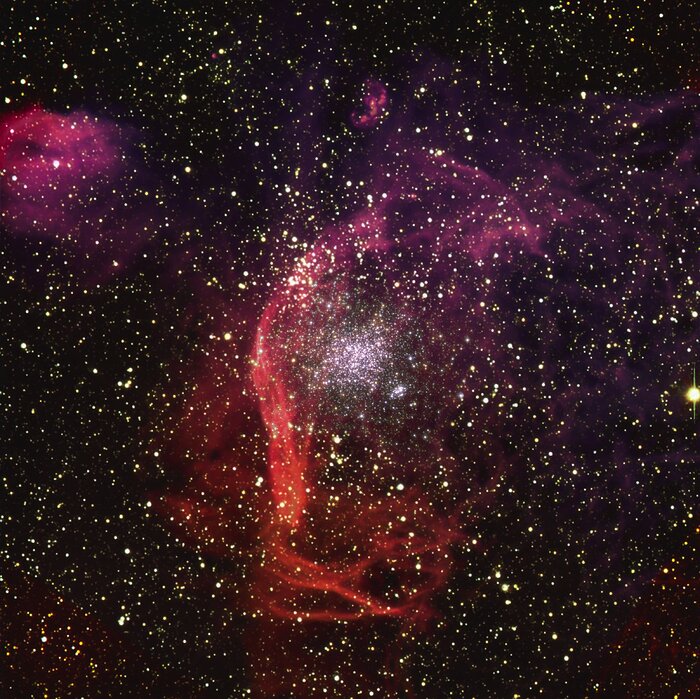
Credit: ESO, NASA/ESA/M. Romaniello
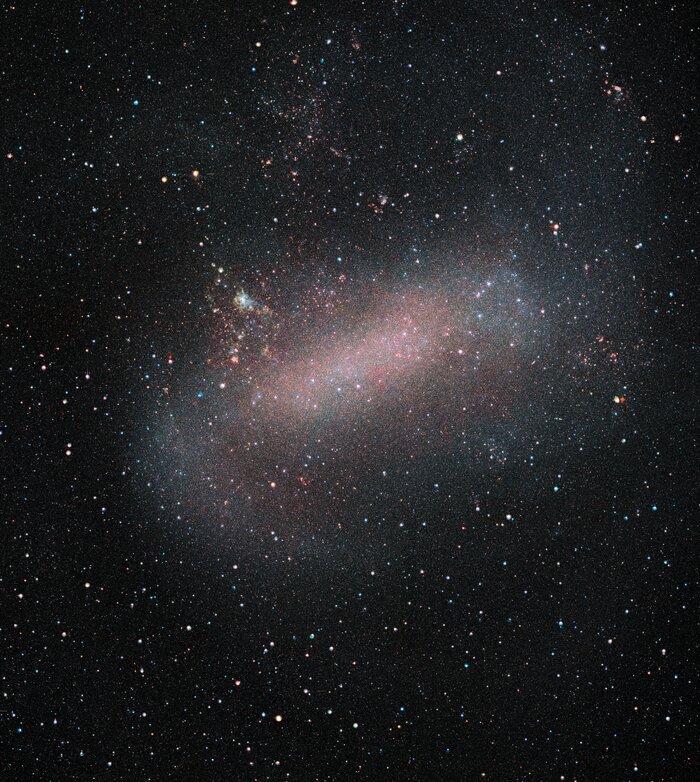
Credit: ESO/VMC Survey
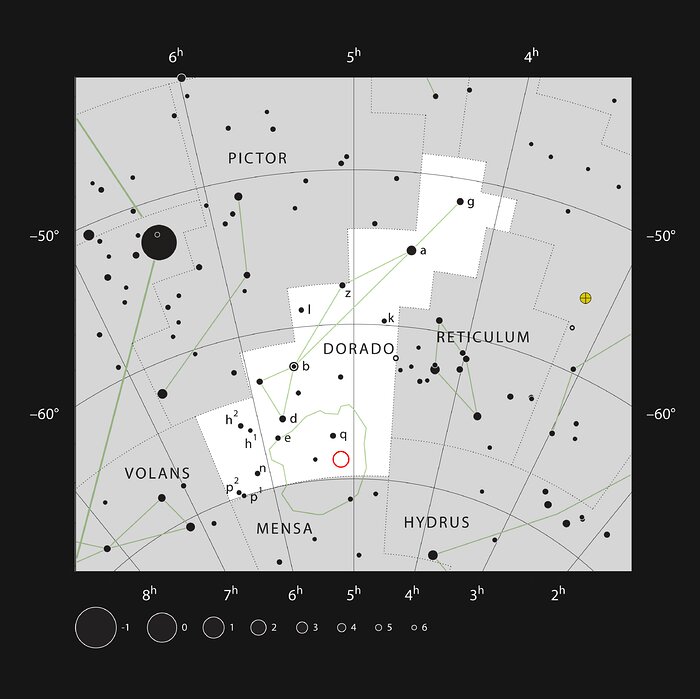
Credit: ESO, IAU and Sky & Telescope
Contacts
Sara Saracino
Astrophysics Research Institute, Liverpool John Moores University
Liverpool, United Kingdom
Email: S.Saracino@ljmu.ac.uk
Sebastian Kamann
Astrophysics Research Institute, Liverpool John Moores University
Liverpool, United Kingdom
Email: S.Kamann@ljmu.ac.uk
Stefan Dreizler
Institute for Astrophysics, University of Göttingen
Göttingen, Germany
Email: dreizler@astro.physik.uni-goettingen.de
Mark Gieles
ICREA, Barcelona, Spain and Institut de Ciències del Cosmos, Universitat de Barcelona
Barcelona, Spain
Email: mgieles@icc.ub.edu
Bárbara Ferreira
ESO Media Manager
Garching bei München, Germany
Tel: +49 89 3200 6670
Cell: +49 151 241 664 00
Email: press@eso.org
35 new events detected by LIGO and Virgo in their latest observation period bring to 90 the gravitational waves detected to date by the global three-interferometer network.
Most of the new signals originate from the whirling spiral of two merging black holes: cosmic quakes that shake the fabric of spacetime, generating a powerful burst of gravitational waves. Two other events, one already reported last June, were instead identified as mergers between a neutron star and a black hole, a source observed for the first time in this last LIGO-Virgo run. A further event, detected in February, 2020, could come from either a pair of black holes or from a mixed pair of a black hole with a neutron star.
The dataset, published today in the so-called third Catalog Paper, outlines the features of new populations of black holes, the masses of which, together with those of the observed neutron stars, may provide clues about how stars live and die, further broadening the horizons of gravitational astronomy.
The Catalog is accompanied by three other publications, focusing on the cosmological and astrophysical consequences of the results and on the multi-messenger search for gravitational-wave signals in coincidence with 86 very energetic bursts (Gammy Ray Bursts) detected in space by the Fermi/GBM and Swift/BAT instruments, during the second part of the third observation period. No confident GW counterparts have been observed; in parallel, no signals of a different kind (e.g. light and neutrinos) have thus far been reported by telescopes and observatories on Earth or in space following-up the GW signals, i.e. searching for signals emitted by the same source as that which emitted the gravitational waves.
At the same time, the LIGO, Virgo and KAGRA scientific collaborations have today also released the full set of calibrated data recorded by the LIGO and Virgo detectors from November, 2019, to March, 2020. This allows the whole research community to perform independent analyses and checks, maximising the wealth of scientific results.
The progress achieved in a few years by gravitational-wave scientists has been amazing, passing from the first detection to the observation of a number of events per month. This has been possible thanks to the programme of continuous technological upgrades, which have transformed the first pioneering instruments into increasingly sensitive detectors. The progress in detector sensitivity due to the technological upgrades and commissioning is evident, considering that, of the 90 gravitational-wave events published today, as many as 79 refer exclusively to the most recent observation period, which ran from April, 2019, to March, 2020.
The LIGO and Virgo observatories are currently undergoing a further upgrade and will start the upcoming fourth observing period, in the second half of 2022, with an even greater sensitivity, corresponding to a volume of the Universe almost 10 times larger than before and, therefore, a much greater probability of picking up gravitational signals.
"Among the other upgrades at Virgo, we have realised an additional optical cavity (the so-called signal-recycling cavity), which allows to improve the sensitivity band of the detector at high frequencies", said Sebastian Steinlechner, assistant professor at Maastricht University and Nikhef. "This corresponds to an increased capacity of the detector to 'listen' to the final stages of the coalescing pairs, when two black holes or stars merge into one."
The KAGRA detector in Japan is being commissioned and KAGRA plans to join the next observing period. The expansion of the network of detectors able to jointly take data will further increase the accuracy of source localisation, a key feature for future developments in multi-messenger astronomy.
Pagination
- Previous page
- Page 6
- Next page

